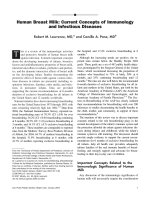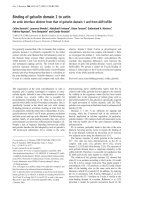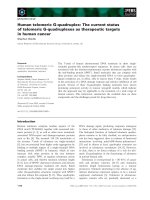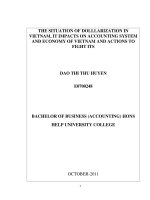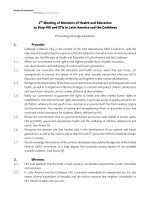Current status of environment and propose to apply an environmental management system follows an international standard organization 14001 at line 1 pha lai thermal power joint stock company
Bạn đang xem bản rút gọn của tài liệu. Xem và tải ngay bản đầy đủ của tài liệu tại đây (854.48 KB, 58 trang )
THAI NGUYEN UNIVERSITY
UNIVERSITY OF AGRICULTURE AND FORESTRY
LA THI THUY
TOPIC TITLE: CURRENT STATUS OF ENVIRONMENT AND PROPOSE TO
APPLY AN ENVIRONMENTAL MANAGEMENT SYSTEM FOLLOWS AN
INTERNATIONAL STANDARD ORGANIZATION 14001 AT LINE 1 PHA
LAI THERMAL POWER JOINT STOCK COMPANY
BACHELOR THESIS
Bachelor mode : Full time
Major
: Environmental Science and Management
Faculty
: International Training and Development Center
Batch
: 2010 - 2015
Thai Nguyen, 23/01/ 2015
Thai Nguyen University of Agriculture and Forestry
Degree Program :
Bachelor
of
Environmental
Science
and
Management
Student name :
La Thi Thuy
Student ID :
DTN 1053110192
Thesis Title :
Current status of environment and propose to
apply an environmental management system
follows an international standard organization
14001 at Line 1 Pha Lai Thermal Power Joint
Stock Company
Supervisor (s):
Dr. Nguyen Thanh Hai
Abstract
During recent years a lot of research has been done in order to
investigate the purpose of ISO 14001 and problems occurring during its
implementation. Environmental Management Systems (EMS) like ISO 14001 is
often criticized for not being the drive force of environmental benefits that it
was intended to. In Thermal Power JSC the ISO 14001 EMS is not widely used
yet. Moreover, no studies have been made so far to evaluate the use of ISO
14001 in this country.
In 2004 the author of this thesis was given the opportunity to work with
Line.1 - Pha Lai Thermal Power JSC and implement ISO 14001. During this
process several problems occurred which formed the basis for this thesis. This
thesis is an assessment of the implementation process of ISO 14001 by using
questioner. It is based on a four-month practical experience of implementing
ISO 14001.
The results show that the main reasons for implementing ISO 14001 at
construction. Companies in Line.1 are 1) staying in competition 2) to improve
i
company image and 3) to deal with environmental issues and that lack of
finances for implementation is not considered as a problem. Furthermore, it is
shown that, most companies have problems implementing ISO 14001.
According to this thesis, those problems are mainly related to human resources
such as working habits, employee awareness and attitudes toward
environmental issues. Suggestions are given to prevent these identified
problems. This thesis concludes that the general criticism toward ISO for not
being the driving force for gaining environmental benefits is justified, also in
Line.1 - Pha Lai Thermal Power JSC.
Keywords:
Environmental
problems,
environmental
pollutants,
environmental management system, international standard
organization.
Number of Pages:
48 pages
Date of
January 23, 2015
Submission:
ii
ACKNOWLEDGMENT
I would like to express my sincere gratitude to my supervisor, Dr. Nguyen
Thanh Hai, for supporting me all the way through this thesis. Her invaluable
encouragement interesting viewpoints and constructive comments on this thesis
have been highly appreciated.
Further I am very grateful to Mrs. Nguyen Thi Thu Huyen who has
supported me through this thesis in Institute of Energy, gave me many good ideas
and was my guiding light.
I’m also thankful to staffs working at the Counseling Center of Thermal
Power - Nuclear Power and Environment - Energy Institute has directly
facilitated and helped me during practice there and investigation fieldwork in the
study area. Thank you for your time and willingness to share your viewpoints
with me.
Finally I would like to thank all my friends, especially my family for their
great support.
Thai Nguyen, Date…. Month….Year 2015
The implementation
La Thi Thuy
iii
TABLE OF CONTENT
LIST OF FIGURES..............................................................................................1
LIST OF TABLES................................................................................................2
LIST OF ABBREVIATIONS ..............................................................................3
PART 1. INTRODUCTION ................................................................................4
1.1. Research rationale ...........................................................................................4
1.2. Research’s objectives ......................................................................................5
1.3. Research questions and hypothesis .................................................................6
1.4. Limitations.......................................................................................................6
1.5. Definitions .......................................................................................................6
PART II. LITERATURE REVIEW ...................................................................7
2.1. Rationale..........................................................................................................7
2.1.1. The concept ofenvironmental problems and environmental management
system .....................................................................................................................7
2.1.2. Introduce about ISO .....................................................................................8
2.1.3. Environmental Management System applies ISO 14001.............................9
2.1.4. Features of EMS are used ISO 14001 ........................................................10
2.2. Legal basic.....................................................................................................11
2.3. Practical basis ................................................................................................12
2.3.1. Current status applies EMS ISO 14001 in the world .................................12
2.3.2. Current status of applies EMS ISO 14001 in Vietnam ..............................13
PART III. METHODS .......................................................................................16
3.1. Materials ........................................................................................................16
3.2. Methods .........................................................................................................16
3.2.1. Gathering secondary materials ...................................................................16
3.2.2. Summarizing methods ................................................................................16
3.2.3. Comparison methods ..................................................................................17
PART IV. RESULTS..........................................................................................18
iv
4.1. Briefly introduction about Line.1 ..................................................................18
4.2. Current status of environment .......................................................................21
4.2.1. Current status of air ....................................................................................21
4.2.2. Current status of wastewater. .....................................................................24
4.2.3. Noise and vibration.....................................................................................26
4.2.4. Solid waste..................................................................................................27
4.3. Comparison between the requirements of ISO 14001 with the current status
of EMS at Line.1–Pha Lai Thermal Power JSC and propose to apply an EMS
follows ISO 14001................................................................................................27
PART 5. DISCUSSION AND CONCLUSION ................................................44
5.1. Discussion......................................................................................................44
5.2. Conclusion .....................................................................................................45
LIST OF REFERENCES...................................................................................47
APPENDIXES
v
LIST OF FIGURES
Figure 2.1. Distribution of ISO 14001 certification in the world in 2013............13
Figure 2.2. Growth of ISO 14001 certification in Vietnam. ................................14
Figure 4.1. Organizational chart of Pha Lai Thermal Power JSC........................19
1
LIST OF TABLES
Table 2.1. Summary of statistical data on the growth rate of ISO certification in
2012 and 2013 ........................................................................................................9
Table 4.1. Total labor of Pha Lai Thermal Power JSC ........................................20
Table 4.2. Concentrations of pollutants at Line.1 ................................................22
Table 4.3. Quality of domestic wastewater after processing of Line.1 ................25
Table 4.4.the quality of wastewater contaminated after processing of Line.1.....26
Table 4.5. Comparison between requirements of No 4.1 with current status of
EMS at Line.1.......................................................................................................27
Table 4.6. Comparison between requirement 4.2 environmental policies with
current status of EMS at Line.1 ............................................................................28
Table 4.7. Comparison between requirement 4.3 planning with current status of
EMS at Line.1.......................................................................................................29
Table 4.8.Comparison between requirement 4.4 implementing and operating with
the current status of EMS at Line.1 ......................................................................32
Table 4.9.Comparison between requirements 4.5 Checking with the current status
of EMS at Line.1 ..................................................................................................38
Table 4.10.Comparison between requirement 4.6 considerations of leadership
with current status of EMS at Line.1....................................................................42
2
LIST OF ABBREVIATIONS
AP
: Administration Personnel
C
: Concentration
EA
: Environmental Aspects
EM
: Environmental Management
EMS
: Environmental Management System
EP
: Environmental Protection
ESP
: Environmental System Protection
FP
: Fire Prevention
ISO
: International Standard Organization
JSC
: Joint Stock Company
PDCA
: Plant – Do - Check – Act
3
PART I. INTRODUCTION
1.1. Research rationale
Environmental protection is the task of social identity string, tied to the
struggle to reduce poverty in each country with the struggle for peace and social
progress. Currently, the environment is one of the issues with different levels and
branches that gained worldwide attention because of following remarkable
achievements in economics, the consequences for the environment is a very large
number of the impact and consequences of human-induced environmental, some
countries in the world have been interested and have an appropriate investment
for environmental issues, modern science as well contribution in finding and
implementing solutions to environmental problems. But so far the development
of increasing scientific and technological promises have yet effective solutions to
environmental problems which only contributes to minimize the rate of
environmental destruction.
Environmental pollution is a topical issue in the media forum because of
recent discovery of a series of environmental pollution caused by a number of
businesses. Consumers today not only want to use the goods of good quality, but
also environmentally friendly. Therefore, enterprises want to survive and
sustainable development cannot be put environmental issues outside business
development strategy of the business; to ensure that the business needs to do and
to be able to manage and minimize the impact on our environment. That is why
the introduction of the ISO 14001 Environmental Management System (EMS),
this is the tool that helps businesses use to proactively prevent environmental
pollution instead of dealing passive implementation
Through the construction of EMS ISO 14001, companies can enhance the
value of their image in the minds of consumers and overcome the technical
barriers to rise compared with the products of other company.
Standing before that reality, Line.1 - Pha Lai Thermal Joint Stock
Company (JSC) is one of the factories operating in the power generation,
therefore how to create the brand and its products entering the domestic market is
4
very necessary. The construction of the environmental management system ISO
14001 is the right thing to do, which gives the plant its visual enhancement of
environmental protection activities with trade partners and consumers, helping
reduce product costs, improve profits by controlling the production process. In
addition, it also raises awareness of environmental protection, prevent the
depletion of natural resources and ensure the health of workers.
For Vietnam’s businesses, ISO 14001 is quite new and they will meet
many difficulties requires, especially investment in terms of money and
manpower about training environment. Currently in the power generation
industry with very few companies achieve ISO 14001, accounting for about 14%
of large businesses operating in the field of electricity production in Viet Nam. In
the future, Line.1 - Pha Lai Thermal Power JSC need to be considered and apply
the ISO 14001 because this Line.1 rated as relatively large and capital as well as
technical equipment but the quality was too old and need be replaced to minimize
the impacts related to the environment in and outside the Line.1.
However, before applying, we should have specific assessment of the
applicability of the Line.1 according to the requirements in terms of ISO 14001
EMS and the initial proposal to help managers and strategic planning of the
company have the appropriate decision.
I conducted research on the subject: "Current status of environment and
propose to apply an environmental management system follows an
international standard organization 14001 at line 1 – Pha Lai Thermal Power
Joint Stock Company" under the guidance of Dr. Nguyen Thanh Hai - Thai
Nguyen University of Agriculture and Forestry.
1.2. Research’s objectives
-To study the current status of environment at Line.1 – Pha Lai Thermal
Power JSC.
-To compare the different between the requirement of ISO 14001 with the
current status of EMS at Line.1
- To propose solutions to construct EMS following ISO 14001 at Line.1.
5
1.3. Research questions and hypothesis
Question: Whether the current status of EMS at Line.1 could be applied by the
requirement of ISO 14001.
Hypotheses:
We can reduce the affect of environmental problems by EMS follows ISO 14001.
How can Line.1 apply EMS follows ISO 14001.
1.4. Limitations
This project could not considered all environmental problems at Pha Lai
Thermal Power JSC and Pha Lai Thermal Power JSC is old thermal company in
Vietnam therefore the requirement to apply EMS follows ISO 14001 is long-term
apply and needs the considering of Department of Environment of Hai Duong.
The investigation is big problem about money and man power.
1.5. Definitions
Environmental problems is one of the greatest problems that the world is facing
today is that of environmental pollution, increasing with every passing year and
causing grave and irreparable damage to the earth. Environmental pollution
consists of five basic types of pollution, namely, air, water, soil, noise and light.
Environmental management system is a management tool used to direct
and control all activities of an organization capable of causing impacts to
environment. The background of environmental management systems is based on
the requirements of ISO 14001 methodologies is Plan - Do - Check - Act
(PDCA).
ISO stands for International Organization for Standardization.
ISO 14001 is environmental management system, guideline and
regulation.
6
PART II. LITERATURE REVIEW
2.1. Rationale
2.1.1. The concept of environmental problems and environmental management
system
Environmental problems is one of the greatest problems that the world is
facing today is that of environmental pollution, increasing with every passing
year and causing grave and irreparable damage to the earth. Environmental
pollution consists of five basic types of pollution, namely, air, water, soil, noise
and light (Hung, H.V. 2008).
Air pollution is by far the most harmful form of pollution in our
environment. Air pollution is cause by the injurious smoke emitted by cars,
buses, trucks, trains, and factories, namely sulphur dioxide, carbon monoxide and
nitrogen oxides. Even smoke from burning leaves and cigarettes are harmful to
the environment causing a lot of damage to man and the atmosphere.
Water pollution caused industrial waste products released into lakes,
rivers, and other water bodies, has made marine life no longer hospitable (Thanh,
D.N. 2008).
Noise pollution, soil pollution and light pollution too are the damaging the
environment at an alarming rate. Noise pollution include aircraft noise, noise of
cars, buses, and trucks, vehicle horns, loudspeakers, and industry noise, as well
as high-intensity sonar effects which are extremely harmful for the environment.
Soil pollution, which can also be called soil contamination, is a result of acid
rain, polluted water, fertilizers etc., which leads to bad crops. Soil contamination
occurs when chemicals are released by spill or underground storage tank leakage
which releases heavy contaminants into the soil.
Light Pollution includes light trespass, over-illumination and astronomical
interference.
Environmental management system is a management tool used to direct
and control all activities of an organization capable of causing impacts to
environment. The background of environmental management systems is based on
7
the requirements of ISO 14001 methodologies is Plan - Do - Check - Act
(PDCA).
2.1.2. Introduce about ISO
ISO
stands
for
International
Organization
for
Standardization
(International Organization for Standardization), was established in 1946 and
formal operations on 02.23.1947 for the purpose of building standards for
production trade and information. ISO is headquartered in Geneva (Switzerland)
and is a specialized international organization with members that the national
standards bodies of 165 countries (Edwards, A.J. 2004).
The purpose of ISO is to facilitate the exchanges of goods and services
worldwide become easier, more convenient and efficient to achieve. All the
standards set forth by ISO are voluntary.
Table 2.1 shows the change in the number of ISO certification in the
world in 2012 and 2013, through which we see that the ISO has been a major
concern for businesses around the world. ISO has published more than 19500
International Standards covering almost every industry, from technology, to food
safety, agriculture and healthcare. Today ISO has members from 165 countries
and 3 368 technical bodies to take care of standard development. More than 150
people work full time for ISO’s Central Secretariat in Geneva, Switzerland.
8
Table 2.1. Summary of statistical data on the growth rate of ISO
certification in 2012 and 2013
Number of
Number of
certificate in
certificate in
2013
2012
ISO 9001
1 129 446
1 096 987
32 459
3%
ISO 14001
301 647
284 654
16 993
6%
ISO 50001
4 826
2 236
2 590
116%
ISO 27001
22 293
19 620
2 673
14 %
ISO 22000
26 847
23 278
3 569
15%
ISO/TS 16949
53 723
50 071
3 652
7%
ISO 13485
25 666
22 317
3 349
15 %
1 564 448
1 499 163
65 285
4%
Standard
Total
Number of
growth rate
Percent of
growth rate
(%)
(Source: www.iso.org )
2.1.3. Environmental Management System applies ISO 14001
ISO 14000 is the standard for environmental management by ISO issued
to help organizations/enterprises reduces harmful impact on the environment
and constantly improving results environmental action. The ISO 14000 standard,
including relevant aspects of environmental management systems such as
environmental management, life cycle assessment of products, eco-labels,
identification and inventory of greenhouse gases (James, E.H. 2011 &
Jorgensen, T.H. 2000).
International Organizations for Standardization has
issued the first ISO14000 standards at the end of the first millennium (1996), to
date, these standards have been revised for the second time (the latest version is
issued 2004). 1997: the standard of ISO14000 standards fully launched,
including a number of criteria:
ISO 14001 - "Environmental Management System. Regulations and
Guidelines ";
ISO 14004 - "Environmental Management System. General guidelines
on principles, systems and supporting techniques";
9
ISO 14010 - "Guidelines for Environmental Assessment. The general
principles";
ISO 14011 - "Guidelines for Environmental Assessment. The process of
evaluation. Evaluation of environmental management system";
ISO 14012 - "Guidelines for Environmental Assessment. Standard
capacity for environmental assessments."
- In 2004: Standard ISO 14001 - 2004 version released in (replacing the
standard ISO14001 edition 1996).
- On 17/07/2009 ISO reviewed and issued standard ISO 14001: 2009 with
the name of the ISO 14001: 2004/Cor 1:2009 version of ISO 14001, this
adjustment was enacted to ensure compatibility after the promulgation of
standards for quality management system ISO 9001:2008. ISO 14001 has been
accepted in Vietnam became the national standard: ISO 14001:2010 Environmental Management System (Harmony, J. 2013).
- Currently, ISO 14001 is being used by at least 223,149 organizations in
over 160 countries and economies.
ISO 14001 is the first certification in EMS. This standard is voluntary and
was developed by ISO 14001 aims to potentially be applied to all types of
organizations and to adapt to the conditions of geography, cultures and different
societies. The overall objective of the ISO 14001 standard and other kinds of sets
of ISO 14001 to protect the environment and prevent pollution in harmony with
the social and economic needs. ISO 14001 is applicable to all types of
organizations, regardless of size, type of activity or product (Ho, P.N & Ca, H.X.
2012).
2.1.4. Features of EMS are used ISO 14001
- EMS as part of the overall management of the organization refers to the
environmental aspects (EA) arising from the activities of that organization.
- EMS helps organizations to achieve the objectives of environmental
protection and toward continuous improvement system.
- Environmental Management System - ISO 14001 as follows:
• Applies to all types of products.
10
• The implementation is voluntary.
• The success of the system depends on the commitment of all
departments and individuals involved.
• Support for environmental protection and pollution prevention.
• Establish, implement, maintain and improve an EMS.
• Ensure all activities consistent with environmental policy were
announced.
• Prove that the suitability for other organizations.
• EMS’s organization is certified as fit by an external organization level.
• Self-defined and declared in accordance with this standard.
2.2. Legal basic
Some government policies relating to the application of ISO 14001 and
Environmental Protection Act
- Circular No.43 of the Ministry of Natural Resources and Environmental
defined "National Technical Standards on Environment" (Circular 43/2010/TTBTNMT). Circular No. 41 of the Ministry of Natural Resources and Environmental
defined "national technical standards on environment" (Circular 41/2010/TTBTNMT). Circular No. 42 of the Ministry of Natural Resources and Environmental
regulations "National Standards for the environment" (Circular 42/2010/TTBTNMT)
- Decision of the Prime Minister 256/2003/QD-TTg dated 02/12/2003
regarding the approval of the strategic national environmental protection in 2010
and 2020 orientation.
- Directive of the Prime Minister 26/2007/CT-TTg dated 26/11/2007 of
the track monitor and evaluate the implementation of planned spending on
resources - environment and sustainable development firmly.
- Environmental Protection Act 2005 by the National Assembly of the
Socialist Republic of Vietnam XI session8thon 29/11/2005 and is effective from
01/07/2006.
- Directive 36-CT/TW on strengthening environmental protection during
the period of industrialization and modernization of the country.
11
- Decree No.21/2008/ND-CP dated 28 May 02, 2008, modified and
supplemented a number of articles of Decree No.80/2006 dated 09 May 08, 2006
by the Government on the detailed provisions and guiding a number of articles of
the Law on Environmental Protection.
- Decree No.117/2009/ND-CP on the handling of administrative violations
in the field of environmental protection. Decree shall take effect as of
01/03/2010.
- Law on Water Resources, Law No.17/2012/QH13 by the National
Assembly of the Socialist Republic of Vietnam on June 21, 2012.
- Decree No.29/2011/ND-CP dated 28/4/2011 of the Government on
strategic environmental assessment, environmental impact assessment, and
environmental protection commitments.
- QCVN 26:2010/BTNMT: National Technical Regulation of noise, time
from 6 hours to 21 hours (according to the audio equivalent).
- QCVN 14:2008/BTNMT - National Technical Regulation of domestic
wastewater
- QCVN 19:2009/BTNMT - National Technical Regulation on industrial
emissions of dust and inorganic substances
- QCVN 20:2009/BTNMT - National Technical Regulation on industrial
emissions for a number of organic compounds
- QCVN 27:2010/ BTNMT - National Technical Regulation on vibration
- QCVN 40:2011/BTNMT - National Technical Regulation on industrial
wastewater
- QCVN 07:2009/BTNMT - National Technical Regulation on waste
threshold.
2.3. Practical basis
2.3.1. Current status applies EMS ISO 14001 in the world
Accompany the development of the society which is the introduction of
various types of businesses and organizations that come into operation when all
causes of environmental impacts with different levels of influence, the problem is
that the joints with different scales should do to be able to manage and minimize
12
the impact on our environment. That is why the introduction of the ISO 14001
environmental management system. Launched for the first time in 1996, ISO
14001 is now available in 138 countries and territories and has over 140,000
businesses / organizations to be certified (Edwards, A.J. 2004).
By the end of 2013 there were at least 223149 ISO 14001 certificates had
been issued in 159 countries and economies, the growth rate is almost the same
in 2008 with 34 334 certification standards in 2013 compared with 34242
certificates standards issued in 2012. The level of certification standards before it
reached 188,815 certificates in 155 countries and economies. Figure 2.1
represents the number of ISO 14001 certification in the world and through which
we see the Top 10 Most countries apply.
Figure 2.1. Distribution of ISO 14001 certification in the world in 2013
(Source: www.iso.org )
In terms of countries around the world, Japan is the country with the
largest percent of applying ISO 14001 and after that is China. From this fact, we
can know that Japan is a country with great attention to the environment (James,
E. H. 2011)
2.3.2. Current status of applies EMS ISO 14001 in Vietnam
In 1998, after two years of being issued, ISO 14001:1996 is the first level.
Since then, the number of organizations applying ISO 14001 certified and
constantly increasing, at first, the company is located in Vietnam applying ISO
13
14001 mostly foreign factories or joint ventures with foreign countries, especially
Japan. This is understandable because Japan has always been at the forefront of
environmental protection and the application of ISO 14001. On the other hand
Japan is one of the countries investing in Vietnam very soon and a large
proportion of the total head foreign investment in Vietnam. There are so many
Japanese companies doing business in Vietnam, may include some major
corporations such as Honda, Toyota, Panasonic, Canon, Yamaha ... Most of the
plant's parent organizations have already adopted ISO 14001 and they require the
plants in the country are required to develop and apply ISO 14001. Therefore,
these companies have also contributed greatly in the development trend of the
application of ISO 14001 in Vietnam (Harmony, J. 2013).
With the increasing number of organizations/enterprises with foreign
factors apply ISO 14001, the national organizations have realized the importance
of the protection of the environment and they also have strategies in the
application of ISO 14001. Most enterprises member of cement plants as Hoang
Thach Cement, Bim Son, Hoang Mai ... also has and in the process of developing
environmental management system ISO 14001. Recently, a series of hotel
members of Saigon Tourist Corporation has been certified to ISO 14001(Be,
L.V. 2006).
Figure 2.2. Growth of ISO 14001 certification in Vietnam.
(Source: www.iso.org )
14
In Vietnam nowadays, ISO 14001 certification has been granted for many
organizations with different types of production and service business is quite
diverse, including industries such as food processing (sugar, seafood , alcoholic
beverage ...), Electronics, Chemicals (oil, paint, plant protection), Building and
Materials, Travel - Hotels account for a large proportion (Thao, N.T. 2005).
However, compared with the number of thousands of businesses have
been certified for quality management system ISO 14001, the number of power
plants applicable standards of environmental management is still small. This
suggests that in Vietnam, the power plant has yet to pay proper attention to
environmental issues and environmental protection (Boiral, O. & Sala, J.M.
1998).
15
PART III. METHODS
3.1. Materials
- Subject: Environmental Management System of Line.1- Pha Lai Thermal
Power JSC
- Scope: To study the content and requirements of ISO 14000 and ISO
14001 standards for proposed construction program of environmental
management system ISO 14001 in accordance with a real working model
practices, namely Line.1- Pha Lai Thermal Power JSC- Chi Linh District - Hai
Duong Province.
- Location and time: Location: Line.1–Pha Lai Thermal Power JSC - Pha
Lai Ward - Sao Do Town – Chi Linh District –Hai Duong Province. Time: From
September, 2014 to December, 2014
- Contents: Summary about Line.1–Pha Lai Thermal Power JSC; current
status of environment of Line.1; comparison between requirement of ISO 14001
with current status of EMS at Line.1 and propose to apply EMS follows ISO
14001.
3.2. Methods
3.2.1. Gathering secondary materials
- Gathering materials about ISO 14001 and other standards, regulation of
Vietnam about reducing environmental pollution.
- Gather information from books, newspapers, library, internet etc.
- Inherited selective material is available from the Line.1 and related
subjects.
3.2.2. Summarizing methods
- Field observations and direct observation of the activities taking place in
the Line.1.
- Assessing the current state of EMS of the Line.1.
16
3.2.3. Comparison methods
- Comparing the requirements of ISO 14001 with the current status of
EMS at Line.1
- Methods of analysis – comparing: the results of the survey of the current
state of the environment are analyzed, compared based on the requirements of
ISO 14001. Since then, make recommendations and build models for Line.1’s
EMS.
17
PART IV. RESULTS
4.1. Briefly introduction about Line.1
Pha Lai Thermal Power JSC precursor is a company specialized in
producing electricity from coal nature. The company is located in the Chi Linh
Town, Hai Duong province, far 56km from Hanoi capital in the North - East,
close to the northern corner of 18th Street and Thai Binh Pacific river. The
company started construction on 05/17/1980 with 440MW capacities, including 4
group’s turbine generators and 8 boilers; each boiler has 110MW capacities. The
Line.1 has highly technical and economic indicators, Pha Lai Thermal turn into
operation were promptly meet load growth strong in the 80s, Pha Lai Thermal
Power Company has the largest power Line.1 in the northern electric system at
that time. From 1989 to 1993, the Line.1's power output decreases by Hoa Binh
hydropower Line.1 in turn draw on the Northern electricity grid. Since 1994, the
North-South 500kV appeared, unified power system in the country, Pha Lai
Thermal JSC Line.1 is enhanced exploitation (Pha Lai Thermal Power JSC
annual report 2013).
- Line.1 –Pha Lai Thermal Power JSC is built on Pha Lai Ward- Sao Do
Town - Chi Linh District - Hai Duong Province. Line.1’s construction
commenced on 05.17.1980 and completed and put into operation in 1986.
- Duration of the national power grid of Line.1 as following:
+ Unit I: On 10/28/1983
+ Unit II: On 01/9/1984
+ Unit III: On 12/12/1985
+ Unit IV: On 11/29/1986
- Line.1 is designed, fabricated and helped by Russia including 4 units
with 8 high-pressure steam boilers and four steam turbine – generator; operating
under the oven block diagram 2 + 1 machine. A steam boiler which uses natural
circulation pulverized coal fuel producing superheated steam to drive steam
turbines. The power of one unit is 110MW. The total installed capacity of Line.1
is 440MW.
18
- Pha Lai Thermal Power JSC (both 2 lines) including 17 units consisting
of professional technical rooms and workshops, divided into 03 blocks: blocks of
professional technical room, mass and volume repair operation.
- The company operates under the following organizational chart:
Shareholders
Controllers
Directory
Director-general
Vice president in charge of
Vice president in charge of
production
economic
Fuel workshop
Office
Planning – Material
Department
Operation workshop 1
Operation workshop 2
Organization and
Supplementary
Labor Department
Operation workshop
Financial – Accounting
Department
Power – Control
Technical Department
tasks
Chemical Operation
Guard – Fire
workshop
Department
(Source: Pha Lai Thermal Power JSC)
Figure 4.1. Organizational chart of Pha Lai Thermal Power JSC
19




